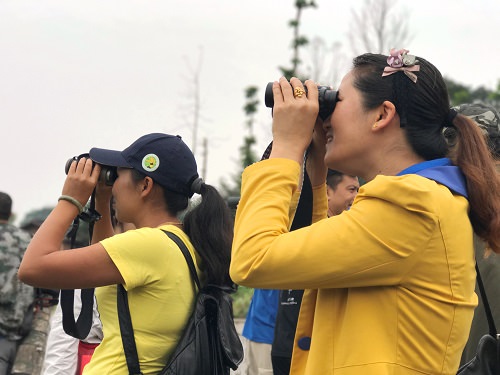Weaver Birds – Nature’s Top Architects
The weaver bird family (Ploceidae) is widely recognized as one of nature’s top architects for its 118 species’ talent in creating intricately woven nests. Their masterpieces of a home are a rival to any human feat of engineering and a source of inspiration for treehouse and hanging chair designers alike. Recently, the Baya Weaver’s handiwork sparked the creativity of engineers at the De Montfort University Leicester in the UK. With the help of 3D printing and lattice architecture technology, the team weaved strips of plastic waste to make bricks that are proven to provide 10 times better insulation than traditional clay bricks, thus reducing electricity and carbon footprint.
.jpg)
In fact, the weavers are not trying to show off their craftsmanship to humans. They see homemaking as one of their most important life event. All they want is to woo potential mates and make a family.
Let’s take a closer look at the Baya Weaver to understand the story behind these much-respected abodes.
A home sweet home weaved with 3,437 “threads”
.jpg)
The responsibility of constructing their signature pendant-shaped nests rests mainly on Baya Weaver males. They tear long strips from leaves of grass, reed, palm or bamboo to use as “threads”. The work begins with tying leaf strips around an anchor point (it can be a branch, a palm leaf or even an electric cable) to hang the nest. Then with a loop here, a tuck there, and the twist of a knot, the bird will make a wreath before moving on to the master bedroom, and finishing with a narrow, downward-pointing tunnel as the front door.
Before the tunnel is built and the nest still resembles a pixie hat, the male weavers would start courting females by calling and fluttering their wings. Females would inspect properties on the market with a critical eye before taking their pick. If the nests receive no interest, its builder would often take it down and start it over, or “generously” let munias, sparrows, bats or tree mice to move in. Only when the male wins over the female would he finish construction, and the female would act as the interior designer, furnishing the bedchamber with soft feathers.
Baya Weavers are gregarious. As many as 60 nests can be found hanging from a tree, while the record was more than 200. A researcher once took an abandoned nest apart and found that it is the product of a whooping 3,437 “threads” – what a feat of dedication and meticulousness!
Location and “feng shui” are the secrets to success
.jpg)
There is more to the nest of the Baya Weaver than meets the eye!
A study found that home location comes before architecture in terms of nesting success. Most parents fail to raise a family due to strong wind and predation by snakes or rodents. So the higher the nest and the sturdier the anchoring point, the higher the nesting success. If the nest is placed on a thorny tree, all the better.
Another research revealed that the orientation of the entrance tunnels is also pivotal. In an experiment, nests placed in windward locations with entrance tubes oriented toward the wind were more likely to lose clutches of artificial eggs than were nests placed in other combinations of placement and orientation. In reality, male weavers do build their nests entrance tubes oriented away from the wind. It looks like weavers are “feng shui experts” too.
You may think male weavers are all born builders. In fact, it takes years of practice for them to master the techniques to make safe and comfortable homes.
Our bird conservation project in Nabang, Yunnan
.jpg)
.jpg)
.jpg)
The Baya Weaver is found throughout Southeast Asia, but it is uncommon in China. Nabang, a bustling avian haven in southwestern Yunnan, is not only one of the few places in China where you can see the Baya Weaver regularly, it is also home to the Wire-tailed Swallow, Streaked Weaver, and nine species of kingfishers.
In 2017, KFBG’s Conservation China Department and the local government helped Nabang establish a birdwatching society to promote community-based bird conservation. The society’s members started to plant rice and corn again to provide food for their feathery neighbours, protect forests to safeguard bird habitat, and build bird hides to provide a better birdwatching experience. We are pleased that the society now has more than 10 members and runs four bird hides. Their success encouraged the local government to explore sustainable development methods that allow people and nature to thrive.

.jpg)
References
BBC News. (2011). 研究發現鳥類需要學習才會築巢. Retrieved from https://www.bbc.com/zhongwen/trad/science/2011/09/110926_birds_nest
Craig, A. (2020). Baya Weaver (Ploceus philippinus), version 1.0. In Birds of the World (J. del Hoyo, A. Elliott, J. Sargatal, D. A. Christie, and E. de Juana, Editors). Cornell Lab of Ornithology, Ithaca, NY, USA. https://doi.org/10.2173/bow.baywea1.01
De Montfort University. (2019). Bird nest inspires engineers to build new bricks from plastic waste. Retrieved from https://www.dmu.ac.uk/about-dmu/news/2019/november/bird-nest-inspires-engineers-to-build-new-bricks-from-plastic-waste.aspx
Madoc, G. C. (1956). An introduction to Malayan birds. Malayan Nature Society, Kuala Lumpur. (revised ed.)
Quader, S. (2006a). Sequential settlement by nesting male and female Baya weaverbirds Ploceus philippinus: the role of monsoon winds. Journal of Avian Biology, 37(4), 396-404. Retrieved from https://doi.org/10.1111/j.0908-8857.2006.03607.x
Quader, S. (2006b). What Makes a Good Nest? Benefits of Nest Choice to Female Baya Weavers (Ploceus philippinus). The Auk, 123(2), 475-486. Retrieved from www.jstor.org/stable/4090676
Winkler, D. W., S. M. Billerman, and I.J. Lovette (2020). Weavers and Allies (Ploceidae), version 1.0. In Birds of the World (S. M. Billerman, B. K. Keeney, P. G. Rodewald, and T. S. Schulenberg, Editors). Cornell Lab of Ornithology, Ithaca, NY, USA. Retrieved from https://doi.org/10.2173/bow.plocei1.01

